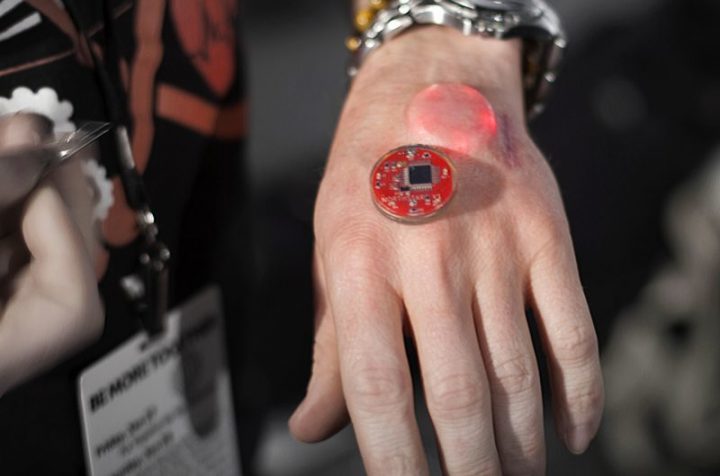Body Hacking: Design for New Sensations

frog
This article presents content originally published in DesignMind, a design journal operated by frog. It is delivered through translation by Transmedia Digital Inc. under the supervision of Mr. Noriaki Okada of DentsuCDCExperience Design Department.
The Era When Everyone Embeds Chips in Their Bodies
Body hacking (body modification) enables the enhancement of innate senses or the realization of entirely new sensations, elevating the human experience. As an interaction designer who has implanted an RFID chip and a magnet into my own hand, I find myself wondering what lies ahead for this trend. Finally, humanity is beginning to design the "medium" of life itself.
The second annual Body Hacking Conference was held this year in Austin, Texas. There, I met a man who had a device larger than a button battery implanted in his hand, with flashing LEDs. Another person had a subdermal piercing that emitted static noise whenever they faced north. The term "body hacking" encompasses everything from piercings to pacemakers, meaning many of us could be considered body hackers in various ways.
Currently, a subculture is emerging that aims to extend the limits of the human body by implanting various devices like chips and sensors. The group "Grinders," pioneers skilled in body hacking technology, operates with a firm social purpose: preparing for the major changes brought about by the fusion of biology and technology.

Not everyone is enthusiastic about such human experimentation. However, some trends observed at body hacking conferences will likely become mainstream someday. Technology and biology have only just begun their awkward first steps toward maintaining a symbiotic relationship while harmonizing with human nature.
If art poses questions and design provides solutions, the idea of body hacking becoming mainstream sits squarely in between. Here, we explore emerging applications of body hacking and the design challenges they present.
Sensory Enhancement
Imagine this: leveraging the sensitivity of your fingertips, with small magnets cleverly placed there, allowing you to sense the presence of iron or electricity. Or, using magnetism, instead of grabbing a gemstone with your hand, it seems to be drawn into your palm...
When performing small actions like opening the refrigerator with an implanted device or picking up headphones, you might suddenly be startled by a tingling sensation in your fingers. During prototype development or while charging a smartphone, sensing the current through the cable can sometimes make you question the practicality of implantable devices.
Technology allows us to use tools as substitutes for sensory organs, yet simultaneously, the mind within our heads gradually shrinks. The fusion of space and body affects our psychological self. Sensory extension enables us to transcend a human-centered perspective and access the world through new means. Such extension will make humans more empathetic beings and us more empathetic designers.
Sensory Proxy
When filmmaker Rob Spence enters a room, few fail to notice the red LED light in his eye. It's immediately clear why he calls himself an "eyeborg." It's only a matter of time before this technology becomes affordable, enabling people like Spence to record video, zoom in to examine details, or even achieve perfect Terminator-like vision through specialized ocular enhancements.
Paul Bach-Wey-Rita is a pioneer of sensory substitution—the attempt to compensate for the loss of one sense with another. He was also the first to widely bring awareness to the brain's plasticity. In 1969, Bach-Wey-Rita proved sensory substitution was possible. In 2015, his wife developed his original research into the "Brain Port," which received FDA approval. Today, visually impaired individuals can see through a tactile interface on their tongue. After completing a brief 10-hour training course over four days, users begin to recognize basic objects using this device.
Additionally, the company Neo Sensory offers the sensory substitution device "VEST." Designed for the hearing impaired, this vest converts sound into tactile sensations. Wearers can understand sentences within weeks, fully mastering this new sense.
The "plug-and-play" nature of these devices is making sensory conversion increasingly feasible, demonstrating just how adaptable the mind can be. With the right training programs to integrate new senses, the potential is enormous. Applying design thinking can make learning more intuitive and lower the barrier to adopting such devices.
Self-Expression
Performance artist Orlan's "Carnal Art Manifesto," written over 20 years ago, foreshadows technologies now permeating the mainstream. Orlan states: "Carnal Art oscillates between damage and reconstitution. What it engraves on the body is the function of our era. The body has become a 'ready-made to be modified'. It is no longer seen as a matter of fantasy as it once was..."
This aesthetic approach to technology is now being embraced by both artists and the fashion industry. Orlan likely influenced Lady Gaga's "facial prosthetics." "Fluorescent tattoos" that glow in the dark using decaying tritium gas, and NFC nails that light up when held near a smartphone reader, have all appeared in fashion shows and circulated online.

Barriers to Mainstream Adoption
Nevertheless, these devices face significant hurdles before becoming mainstream. On the marketing front, companies must help potential customers overcome the psychological resistance to damaging their skin to embed the devices.
They also need to reassure users that they won't be tracked or hacked. While Grinders designs these devices and makes them available for independent body hackers to modify, they are inherently unsafe because safety protocols don't apply.
However, hacking these devices is not easy. For example, if a hacker wanted to see the tiny string of information etched onto my chip to break into my house, they would have to get very close. It would be easier to pick the door lock.
Regarding privacy, companies will undoubtedly want to mine every bit of data collected from these implanted devices. The most likely scenario is companies offering users the option to earn rewards for their data. Still, to advance this field, users must feel confident they own their data. This is especially crucial since the technology itself operates inside the body. The thought of a corporate brand potentially being etched into a part of your own biology is unsettling.
Since the first human chip implantation in 1998, we've come a long way in adoption. Today, there's a growing movement enthusiastically supporting such procedures. Within 10 to 20 years, most wearable devices will likely be implanted. However, for these devices to become mainstream, they must become interconnected.
Today, Apple lets you text your heartbeat. In a few years, you might gain someone else's heartbeat as an additional sense—for instance, to sense when your child or loved one is nearby. While personal privacy is an issue, society will likely weigh the benefits over the drawbacks for this kind of intimate data sharing.
From Prototype to Phenotype
Design research and a thorough understanding of the human body will become more important than ever. Without proper user testing, no one can predict the societal impact.
The rest of this article can be found in the web magazine "AXIS".

Fabiola Einhorn A Swedish interaction designer at frog in Austin. She explores forgotten or hidden truths about the situations surrounding humans and their relationship with technology. With extensive experience designing medical products and services, she applies this knowledge to her exploration of the future of human augmentation. She believes technology should serve design and contribute to the greater good of society.
Was this article helpful?
Newsletter registration is here
We select and publish important news every day
For inquiries about this article
Back Numbers
Author

frog
frog is a company that delivers global design and strategy. We transform businesses by designing brands, products, and services that deliver exceptional customer experiences. We are passionate about creating memorable experiences, driving market change, and turning ideas into reality. Through partnerships with our clients, we enable future foresight, organizational growth, and the evolution of human experience. <a href="http://dentsu-frog.com/" target="_blank">http://dentsu-frog.com/</a>